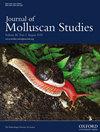The faecal microbiome of the Pacific banana slug, Ariolimax columbianus, displays seasonal variation
IF 1.2
4区 生物学
Q2 MARINE & FRESHWATER BIOLOGY
引用次数: 0
Abstract
The Pacific banana slug, Ariolimax columbianus, is the largest land mollusc in North America and occurs in forests ranging from northwestern California to Alaska. We explored the microbial community found within the faeces of 24 slugs from the Oregon Coast Range. Twenty-four slugs were collected in 2019, 12 in the spring and 12 in the fall. These two time points were selected to investigate the composition of microbial populations in wild-caught slugs, also in response to seasonal changes in available plants as food sources. Results from 16S rRNA gene amplicon sequencing indicate that the most prevalent phyla detected from A. columbianus were Proteobacteria (66%) and Bacteriodetes (16%), similar to previous observations from six other species/genera of terrestrial gastropods (Stylommatophora). The most abundant operational taxonomic units across all specimens were Enterobacter sp., Pseudomonas sp. and Flavobacterium sp. Significant seasonal variation was observed for several species of Flavobacteriales, Firmicutes and Proteobacteria, with the majority showing higher abundance in fall. In contrast to Cornu aspersum (previously Helix aspersa, parapatric with A. columbianus) and Geomaculus maculosus, A. columbianus harbours very low levels of Buttiauxella (0.35%). These findings raise questions about the origin, specificity and selection of specific bacteria as components of the intestinal microbiome of terrestrial gastropods.太平洋香蕉蛞蝓(Ariolimax columbianus)粪便微生物群显示出季节性变化
太平洋香蕉蛞蝓(Ariolimax columbianus)是北美洲最大的陆地软体动物,分布于从加利福尼亚西北部到阿拉斯加的森林中。我们研究了俄勒冈海岸山脉 24 只蛞蝓粪便中的微生物群落。我们在 2019 年收集了 24 只蛞蝓,其中 12 只在春季,12 只在秋季。选择这两个时间点是为了调查野生捕获的蛞蝓体内微生物种群的组成,同时也是对可作为食物来源的植物的季节性变化的回应。16S rRNA 基因扩增片测序结果表明,从大肠蛞蝓中检测到的最普遍的门类是变形菌(66%)和杆菌(16%),这与之前从陆生腹足纲动物(Stylommatophora)的其他六个物种/属中观察到的结果相似。在所有标本中,最丰富的可操作分类单元是肠杆菌属、假单胞菌属和黄杆菌属。黄杆菌属、固缩菌属和变形菌属中的几个物种有明显的季节性变化,大多数在秋季表现出较高的丰度。与 Cornu aspersum(前身为 Helix aspersa,与 A. columbianus 同域)和 Geomaculus maculosus 相比,A. columbianus 中的 Buttiauxella 含量非常低(0.35%)。这些发现提出了陆生腹足类动物肠道微生物组中特定细菌的起源、特异性和选择问题。
本文章由计算机程序翻译,如有差异,请以英文原文为准。
求助全文
约1分钟内获得全文
求助全文
来源期刊

Journal of Molluscan Studies
生物-动物学
CiteScore
3.00
自引率
8.30%
发文量
36
审稿时长
3 months
期刊介绍:
The Journal of Molluscan Studies accepts papers on all aspects of the study of molluscs. These include systematics, molecular genetics, palaeontology, ecology, evolution, and physiology. Where the topic is in a specialized field (e.g. parasitology, neurobiology, biochemistry, molecular biology), submissions will still be accepted as long as the mollusc is the principal focus of the study, and not incidental or simply a convenient experimental animal. Papers with a focus on fisheries biology, aquaculture, and control of molluscan pests will be accepted only if they include significant advances in molluscan biology. While systematic papers are encouraged, descriptions of single new taxa will only be considered if they include some ‘added value’, for example in the form of new information on anatomy or distribution, or if they are presented in the context of a systematic revision or phylogenetic analysis of the group.
 求助内容:
求助内容: 应助结果提醒方式:
应助结果提醒方式:


